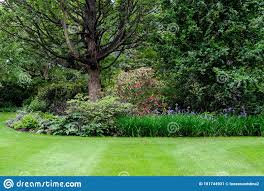This Week’s K-State Garden Hour Webinar:
Best Plants for a Beginner’s Landscape
Wednesday, March 3; Noon – 1:00pm CST
Presented by: Anthony Reardon, West Plains Extension District Horticulture Agent
Join this free gardening webinar the first and third Wednesday of every month. Recordings are made available online, and a one-time registration is required participate in the live webinar series. To register, see upcoming webinars, and view previous webinars, visit: http://ksre-learn.com/KStateGardenHour
REMINDERS
1. Work soil for spring planting of not too wet.
2. Make fungicide application to control Peach Leaf Curl.
TURFGRASS
Why Seeding Cool-Season Grasses in the Spring is Difficult
People often wonder why we recommend seeding cool-season grasses such as tall fescue and Kentucky bluegrass in the fall. It would seem that the spring would be the more natural time for seeding because the entire growing season is available for the grass to become established before the turf has to deal with winter. Actually there are a number of reasons that tend to make fall seedings more successful.
The soils are warmer in the fall. Warm soils mean less time required for germination and growth so the grass becomes established more quickly. I have seen tall fescue seeded in the last week of August come up in four days. Now, you had to be on your hands and knees to see it but it was up. Tall fescue seeded in the spring may take well over a week to come up and the time required to become established is much longer.
Weeds are less of a problem in the fall. The major weed problems in the fall tend to be the broadleaves such as chickweed, henbit or dandelion. Turf seeded in early September is usually thick enough by the time these broadleaves germinate that often there is not much weed invasion. Even if there is some invasion by broadleaves, the turf should be mature enough by early November that mild broadleaf herbicides can be applied.
In the spring, our major weed problems are the annual grasses such as crabgrass. Since the spring-seeded turf is slow to mature, there are often thin areas that are easily invaded by these grassy weeds. If this invasion occurs, the weeds are better adapted to our hot, summer conditions than our cool-season grasses and so the weeds tend to take over. The number of chemicals that can be used on young turf is limited, and so these grasses become more of a problem. One of the preemergence herbicides that can be used on young grasses is dithiopyr (Dimension). It is found in Hi-Yield Turf and Ornamental Weed & Grass Stopper and Bonide Crabgrass & Weed Preventer and can be used on tall fescue, Kentucky bluegrass, and perennial ryegrass two weeks after germination.
Summer is the hardest time of the year for cool-season grasses; not the winter. Summertime is very difficult because our cool-season grasses do not have the heat or moisture stress tolerance that our warm-season grasses such as buffalo, zoysia and Bermuda have. Therefore they tend to become weakened in the summer which makes them more susceptible to disease and other stresses. Spring-seeded cool-season grasses are less mature and therefore less able to tolerate these stresses.
Seeding cool-season grasses in the spring can be successful but is more difficult to pull off than fall seedings. If you have a choice, always opt for seeding cool-season grasses in the fall. (Ward Upham)
Lawn Calendar for Warm-Season Grasses
Following is a lawn calendar for zoysiagrass and bermudagrass. Buffalograss, also a warm-season grass, is covered in a separate article.
March
Spot treat broadleaf weeds if necessary. Treat on a day that is 50 degrees F or warmer if possible. Rain or irrigation within 24 hours of application will reduce effectiveness.
April
Apply crabgrass preventer between April 1 and April 15, or apply preventer when the eastern redbud is approaching full bloom. If using a product with prodiamine (Barricade), apply two weeks earlier. Crabgrass preventers must be watered in before they will start to work.
May – August 15
Fertilize with 1 lb. of nitrogen per 1,000 square feet per application. Follow the recommendations on the bag. More applications will give a deeper green color, but will increase mowing and lead to thatch buildup with zoysia grass. Bermudagrass can also have problems with thatch buildup but thatch is less likely with Bermuda than zoysia.
- Bermuda grass – Use two to four applications.
- Zoysia grass – Use one to two applications. Too much nitrogen leads to thatch buildup.
One Application: Apply in June.
Two Applications: Apply May and July.
Three Applications: Apply May, June, and early August.
Four Applications: Apply May, June, July, and early August.
June
If grubs have been a problem in the past, apply a product containing imidacloprid or chlorantraniliprole during May or anytime from May through June for imidacloprid. These products kill the grubs before they cause damage. They are effective and safe but must be watered in before they become active. June is a good time to core aerate a warm-season lawn. Core aeration will help alleviate compaction, increase the rate of water infiltration, improve soil air exchange and help control thatch.
Late-July through August
If you see grub damage, apply a grub killer. If Imidacloprid has been applied, this should not be necessary. Grub killers must be watered in immediately.
Late October
Spray for broadleaf weeds if they are a problem. Treat on a day that is at least 50 degrees F. Rain or irrigation within 24 hours reduces effectiveness. Use the rates listed on the label for all products mentioned. (Ward Upham)
Lawn Calendar for Buffalo grass
General Comments
Buffalo grass has become more popular in recent years due to its reputation as a low-maintenance grass. Buffalo grass can survive with less water and fertilizer than our other turf grasses.
March
Spot treat broadleaf weeds if necessary. The most important treatment for broadleaf weeds should be in late October to early November well after the buffalo grass is dormant. Treatments are much more effective then than in the spring as the weeds are smaller and the weeds are sending energy, as well as the herbicide, to the roots. Treatments in March are to take care of any “escapes” missed in the fall spraying. Spray early enough in March that the buffalo grass is still dormant. Look at the base of the plants to make sure there is no green. Try to treat on a day that is 50 degrees F or warmer. Rain or irrigation within 24 hours of application will reduce effectiveness. Use a combination product such as Trimec, Weed-B-Gon or Weed-Out. Weed Free Zone is also good and will give quicker results under cool conditions.
April
Apply crabgrass preventer between April 1 and April 15, or apply preventer when the eastern redbud is in full bloom. If using a product with prodiamine (Barricade), apply two weeks earlier. Crabgrass preventers must be watered in before they will work. Avoid using broadleaf herbicides as the buffalo grass is greening up as injury can result. The buffalo grass will not be killed but growth will slow making the buffalo grass less competitive with weeds.
June
Fertilize with 1 lb. of nitrogen per 1,000 square feet during June. More applications will give a deeper green color. If it is felt that a second application is needed, apply in July. If grubs have been a problem in the past, apply a product containing imidacloprid or chlorantraniliprole during May or anytime from May through June for imidacloprid.
Imidacloprid and chlorantraniliprole can be applied as early as mid May if there are problems with billbugs or May beetle grubs. These products kill the grubs before they cause damage. They are effective and safe but must be watered in before they become active. Again, treat only if grubs have been a problem in the past. Note that the whole area may not need to be treated. The beetles that lay the eggs for the grubs are attracted to lights and moist soil and those areas are most likely to be infested.
Late-July through August
If you see grub damage, apply a grub killer. If imidacloprid has been applied or if grubs have not been a problem in the past, this should not be necessary. Grub killers must be watered in immediately.
Late October to Early November
Spray for broadleaf weeds if they are a problem. Look carefully as our winter annuals such as chickweed and henbit are small and easily overlooked. Use a product that contains 2,4-D as it increases effectiveness on dandelions. Treat on a day that is at least 50 degrees F. Rain or irrigation within 24 hours reduces effectiveness. Use the rates listed on the label for all products mentioned. (Ward Upham)
It’s Not Too Late for Dormant Overseeding of Turfgrass
As mentioned in a companion article in this newsletter, the best time to overseed cool-season grasses such as tall fescue and Kentucky bluegrass is September because the turf has more time to mature before crabgrass germination in the spring and the heat stress of summer. However, dormant seeding of turfgrass is sometimes used to help fill in bare spots of lawns that weren’t overseeded in the fall. Dormant seeding is normally not used to seed large areas because of the possibility of erosion before the seed emerges and becomes mature enough to hold the soil.
Dormant overseeding is usually done during the winter (December through February) when it is too cold for germination to take place. Spring seedings done in March can be just as successful as dormant seeding, but spring rains may delay plantings. As with any seeding program, it is vital that good seed-soil contact is achieved. There are several methods that are commonly used in dormant seeding.
One method is to seed when there has been a light snowfall of up to an inch over unfrozen soil. This is shallow enough that bare spots can still be seen. Spread seed by hand on areas that need thickening up. As the snow melts it brings the seed into good contact with the soil where it will germinate in the spring.
Another method is dependent on the surface of the soil being moist followed by some freezing weather. As moist soil freezes and thaws, small pockets are formed on the wet, bare soils which are perfect for catching and holding seed. As the soil dries, the pockets collapse and cover the seed.
If dry enough and the soil is unfrozen, seed can be applied to bare spots and then raked in to ensure good seed/soil contact.
With any of the above methods, seed germinates in the spring as early as possible. There will be limitations on what herbicides can be used for weed control. Tupersan (siduron) can be used as a crabgrass preventer on new seedings even before they have come up. Also dithiopyr, found in Hi-Yield Turf and Ornamental Weed & Grass Stopper and Bonide Crabgrass & Weed Preventer, can be used on tall fescue, Kentucky bluegrass, and perennial ryegrass two weeks after germination. Dithiopyr is longer lasting and more effective than siduron. Other preemergence herbicides available to homeowners require that the turf be well established before application. (Ward Upham)
MISCELLANEOUS
Ash Flower Gall
You may have noticed ugly, brown to black, gall-like masses in ash trees this winter. These growths are caused by the ash flower gall mite. As with most galls, the ash flower gall is unsightly but does not harm the health of the tree. Though most galls are caused by insects, this one is caused by an eriophyid mite, Eriophyes fraxinivorus.
These tiny mites (about 0.5 mm long) feed on the male flower clusters of ash early in the growing season, transforming the male flowers into irregular, fringed masses. These masses persist until the following spring and become more noticeable when the leaves drop in the fall. Masses start out green but turn black as they dry.
As mentioned, the ash flower gall is unsightly but does not harm the health of the tree. The mites are also difficult to control because they are able enter the flower bud before it is visibly open. Control measures are not recommended. (Ward Upham)
Use a String Line and Planting Board
Two simple tools can make planting a vegetable garden easier. A string line is used to ensure straight rows and a planting board can make spacing vegetables within a row easier. Most gardeners make their own string line. A very simple one can be made with a tent peg, a 12″ piece of 1 x 2 lumber and some string. String is wound on the 1 x 2. Either notch each end of the board or drive a nail near each end to hold the string as it is wound. The end of the string is tied to the nail driven into the board. The other end of the string is tied to the tent peg. When marking out a row, drive the tent peg into the ground where you want the row to start. Mark the end of the row with a second tent peg and unwind enough string to stretch between them. Actually, you will want the string line offset where the plants will go by a couple of inches so that it isn’t in your way. In other words, you will make your row next to the string; not under it. You now have the means of making a straight row.
So, what is a planting board? A planting board is a 1 x 4 board that is four feet long. Relatively deep notches are cut every foot with shallow notches at 6 inches from each deep notch. Some gardeners also bevel the side opposite the notches so they can work the beveled end into the soil to make a shallow trench for seed.
When planting, lay the planting board near your tent peg and align it with the string. It is now easy to place plants or seeds at the recommended spacing. Move the planting board with you as you progress down the row. (Ward Upham)
Establishing a Wildflower Area
Native grasses and many native wildflowers do well within a wide pH range. Any pH between 5.5 and 8 should work. Just make sure the area receives at least 8 hours of sun a day.
It is better to choose a blend of grasses and wildflowers rather than a single species. Companies that provide regional blends include Sharp Brothers, Stock Seed and Wildseed Farms.
These plants do not take root and grow well in areas that already have established plants. Existing vegetation should be killed before seeding. Follow the following steps to increase the chances of success.
– Control perennial weeds by using a product containing glyphosate.
– Using glyphosate the fall before planting makes soil preparation easier the following spring
– Adjust pH and fertilize according to soil test before planting.
– The seedbed should be firm so that a boot heel sinks in no more than ½ inch.
– The goal is good seed/soil contact.
– Can mix seed with damp sand (4:1 sand/seed) for more uniform coverage with a drop seeder or whirlybird spreader.
– The seed should be raked in about 1/4″ deep. It is best if the seedbed is firmed up by using roller or driving over the area with a riding lawn mower. Don’t mulch.
– Keep seed moist while the seed is germinating (3 to 4 times per week, if possible). Slowly back off watering as plants develop.
What about planting dates? Warm-season grasses and most prairie flowers should be seeded between April 1 and May 15. To control any remaining living vegetation, spray with a product containing glyphosate, wait a week and plant. Make sure the soil temperature is at least 60 degrees before planting. Soil thermometers are often available in garden centers, hardware stores and auto stores (they are used to test air temperatures from air conditioners as well as in gardens).
Hand weeding can help but must be done with care to avoid uprooting small prairie flowers. Mowing as high as possible can help control fast growing weeds while preserving most of the foliage on the prairie flower. (Ward Upham)
Contributors: Ward Upham, Extension Associate
Division of Horticulture
1712 Claflin, 2021 Throckmorton
Manhattan, KS 66506
(785) 532-6173
For questions or further information, contact: [email protected] OR [email protected]
This newsletter is also available on the World Wide Web at:
http://hnr.k-state.edu/extension/info-center/newsletters/index.html
The web version includes color images that illustrate subjects discussed. To subscribe to this newsletter electronically, send an e-mail message to [email protected] or [email protected] listing your e-mail address in the message.
Brand names appearing in this newsletter are for product identification purposes only. No endorsement is intended, nor is criticism implied of similar products not mentioned.
K-State Research and Extension is committed to making its services, activities and programs accessible to all participants. If you have special requirements due to a physical, vision or hearing disability, or a dietary restriction please contact Extension Horticulture at (785) 532-6173.
https://hnr.k-state.edu/extension/info-center/newsletters/index.html
Blog Post: http://www.ksuhortnewsletter.org
Video of the Week: Building a Raised Bed for Gardens
Ward Upham
Extension Associate
[email protected]
785-532-1438





